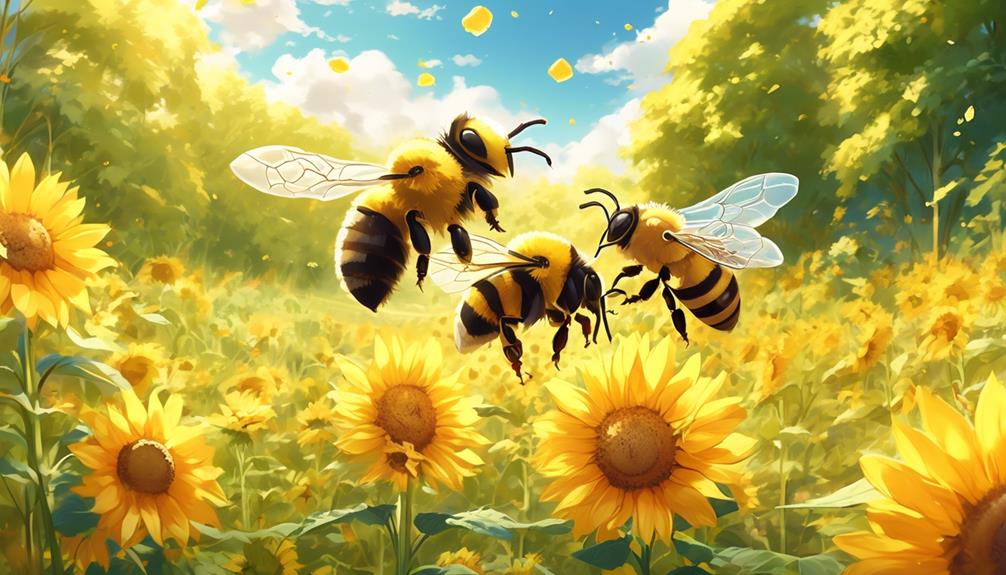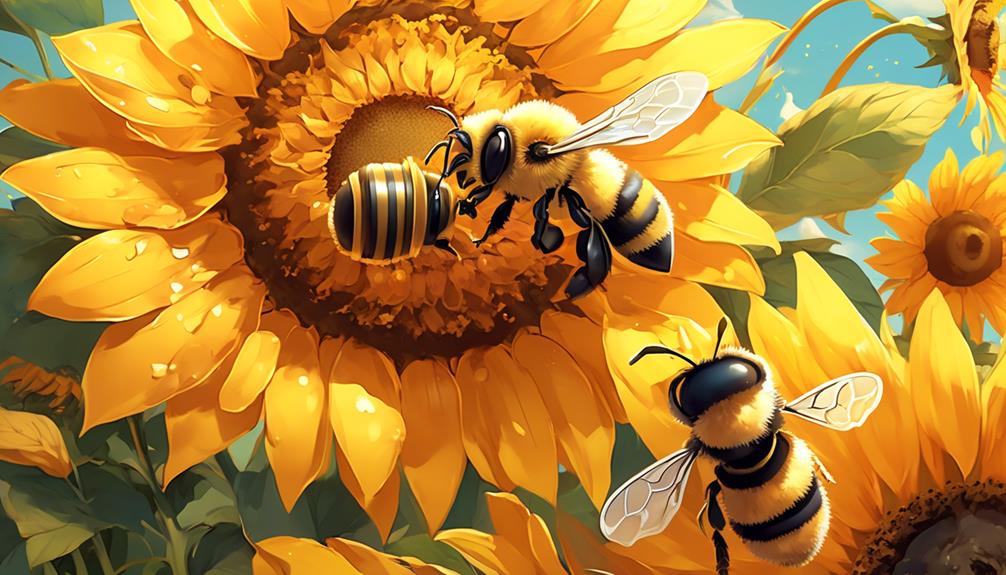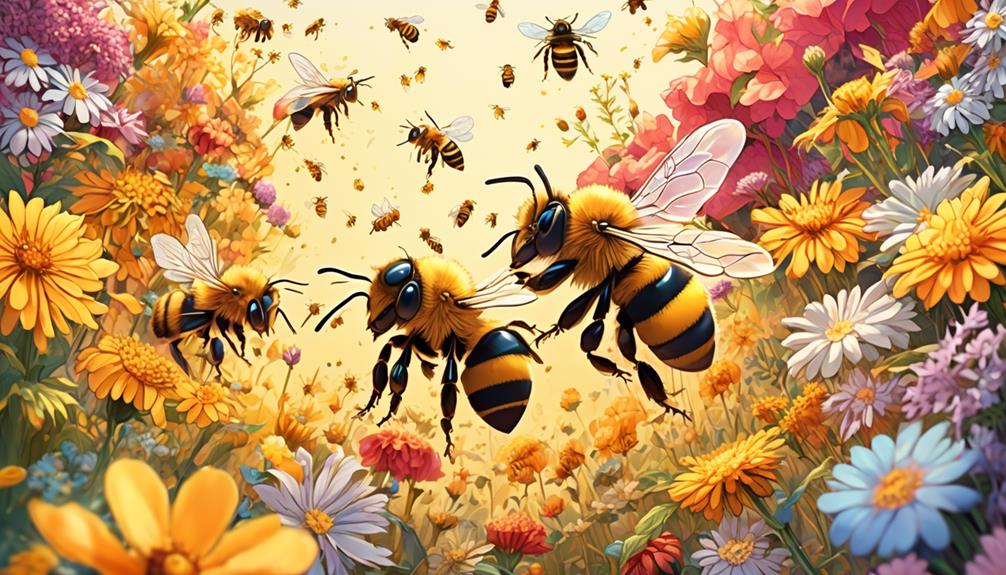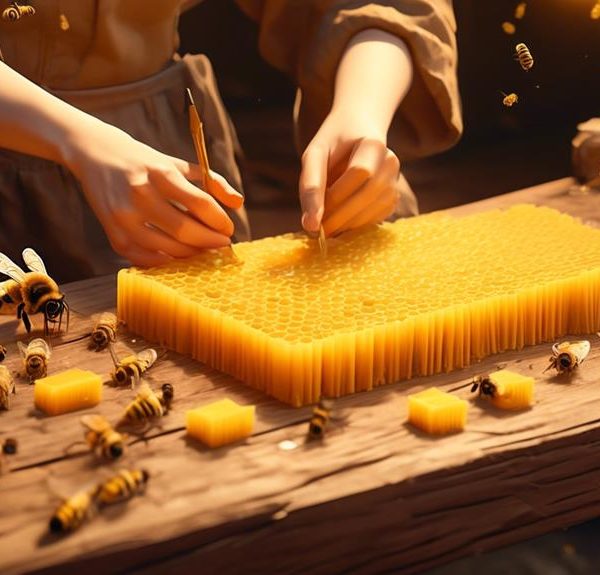Hive dynamics revealed: delve into the intriguing relationship between honey bees and bumblebees, and discover whether they truly get along.

Do Honey Bees and Bumblebees Get Along?
Did you know that there are over 20,000 known species of bees worldwide?
Among these, honey bees and bumblebees are two of the most recognizable and they often share the same habitats.
But you might wonder, how do these busy buzzers interact with each other? Do they coexist harmoniously, or is it a bit more complex than that?
The answers to these questions might surprise you, as they involve intriguing elements of bee behavior, ecology, and competition.
Let's buckle up and explore this fascinating world of bees.
Key Takeaways
- Honey bees and bumblebees often coexist harmoniously and play important roles in the pollination process.
- Honey bees can learn from bumblebees' foraging patterns, indicating a level of communication and adaptation between the two species.
- Occasional disputes over food sources can occur, suggesting some level of competition.
- Factors such as food availability, habitat conditions, climate, and human activities can influence the coexistence of honey bees and bumblebees.
Understanding Honey Bees' Behavior

To fully grasp how honey bees interact with bumblebees, you've got to dive into the intricate details of their unique behavior patterns. Honey bees, like their bumblebee counterparts, live in complex, organized colonies. However, unlike bumblebees, honey bees have a perennial life cycle, meaning their colonies persist year-round. This makes the honey bee social structure much more complex and rigid.
Honey bees communicate through a series of 'dances', the most famous of which is the 'waggle dance'. This unique form of communication is used to convey the location of food sources. They're also known for their meticulous grooming habits, which help to keep the colony healthy.
Honey bees are more aggressive than bumblebees and are more likely to defend their hives. Unlike bumblebees, honey bees can only sting once, as their stinger is barbed and rips from their body after use.
These behaviors play key roles in how honey bees interact with other bees and insects, including bumblebees. By understanding these behaviors, you can better predict and interpret the dynamics between these two bee species.
Unveiling Bumblebees' Social Structure

Now, let's delve into the fascinating social structure of bumblebees, which is markedly different from that of their honey bee counterparts. Where honey bees function within a rigid hierarchy, bumblebees have a more fluid social structure.
At the core of a bumblebee colony, you'll find a queen bee, the mother to all other bees within the nest. She mates once and stores the sperm to fertilise the eggs she'll lay each season. Worker bees, who are all female, carry out most of the colony's tasks, including foraging, feeding larvae, and defending the nest.
Interestingly, bumblebee colonies don't persist year-round. By late summer, the queen lays eggs that will become new queens and males. After mating, these new queens hibernate alone through winter until spring arrives, when they emerge to start their own colonies.
Unlike honey bees, bumblebee males, also known as drones, don't have a stinger and they don't participate in the chores of the colony. Their sole responsibility is to mate with a queen.
In essence, the bumblebee social structure, while more flexible, is still a well-oiled machine promoting survival and propagation.
Interactions Between Honey Bees and Bumblebees

While understanding the distinct social structures of honey bees and bumblebees is crucial, it's equally important to explore how these two species interact with each other in their shared natural environments.
Contrary to what you might expect, honey bees and bumblebees aren't necessarily in direct competition with each other for resources. Instead, they often coexist harmoniously, with each species playing its part in the pollination process. Their interactions are generally peaceful, with occasional disputes over food sources, but these are rare and not typically harmful.
Research has shown that honey bees and bumblebees can even learn from each other. A study published in 'Current Biology' found that honey bees are capable of picking up on the flower preferences of bumblebees by observing their foraging patterns. This suggests a nuanced level of interspecies communication.
However, it's not all rosy. With the intensification of agriculture and the loss of wildflowers, the competition for nectar and pollen can intensify, potentially stressing the relationship between these species.
Factors Influencing Their Coexistence

Often, the peaceful coexistence of honey bees and bumblebees hinges on a variety of factors, including food availability, habitat conditions, and even climatic factors. Both species require a diverse array of flowers from which they can collect nectar and pollen. A scarcity of food resources can trigger competition and disrupt their peaceful coexistence.
Habitat conditions significantly impact their interactions. Both species prefer environments with abundant flowers and suitable nesting sites. Destruction of these habitats can lead to increased competition, affecting their coexistence.
Let's not forget about climatic factors. Honey bees and bumblebees are ectothermic creatures, meaning their body temperature is influenced by the environment. Changes in temperature, rainfall, and seasonal patterns can affect their behavior and interaction.
Here's a quick look at these factors:
Factor | Description |
|---|---|
Food Availability | Diversity and abundance of flowers affect competition |
Habitat Conditions | Destruction of habitats can increase competition |
Climatic Factors | Changes in temperature, rainfall, and seasons influence behavior |
Inter-Species Competition | Dominance of one species can disrupt coexistence |
Human Impact | Pesticides and habitat destruction can affect population dynamics |
Effects of Competition on Bee Populations

Building on the understanding of factors influencing bee coexistence, it's crucial to examine how competition, triggered by these factors, can impact the populations of honey bees and bumblebees. When you factor in resource scarcity, this competition can significantly influence population dynamics.
To begin with, both species need similar resources – pollen and nectar – to survive and reproduce. When these resources are scarce, a fierce competition ensues. This scarcity often arises due to factors such as habitat loss or changes in plant diversity. Honey bees, being more numerous and aggressive, usually outcompete bumblebees, leading to a decline in the latter's populations.
Furthermore, honey bees and bumblebees can transmit parasites and diseases to each other during their interactions. This cross-species transmission, especially from honey bees to bumblebees, can be devastating to the already stressed bumblebee populations.
The competition's cumulative effects can result in skewed population ratios favoring honey bees, potentially leading to a decrease in biodiversity. It's also worth noting that given their different roles in pollination, the decline in one species can have significant impacts on the ecosystem's overall health. Therefore, understanding this competition is vital to creating strategies for bee conservation.
Frequently Asked Questions
What Are the Primary Ways That Honey Bees and Bumblebees Communicate With Each Other?"
You might be surprised to learn that honey bees and bumblebees don't really communicate with each other. They're different species with their own distinct languages.
Honey bees communicate primarily through the 'waggle dance' and pheromones. Bumblebees, on the other hand, rely more on scent marks.
Do Honey Bees and Bumblebees Share Similar Predators, and How Do They Defend Against Them?"
Yes, honey bees and bumblebees share similar predators like birds, spiders, and wasps. They've got unique defense mechanisms.
Honey bees swarm and sting their threat, dying in the process. That's their commitment to protect the hive!
Bumblebees, on the other hand, can sting multiple times without dying. They're less aggressive, though, and often ignore threats unless their nest is directly disturbed.
How Do Changes in the Environment or Climate Affect the Relationship Between Honey Bees and Bumblebees?"
When environmental or climatic conditions change, it directly impacts the relationship between honey bees and bumblebees. You'll find that increased competition for resources can lead to more conflict.
Similarly, changes in plant biodiversity can affect their coexistence. If there's a decrease in flowers, they'll compete more.
Are There Any Known Cases of Honey Bees and Bumblebees Helping Each Other in Any Way?"
Yes, honey bees and bumblebees can help each other in various ways.
For instance, they can share information about good nectar sources. If you observe, you'd see a honey bee following a bumblebee to a flower patch.
Furthermore, the presence of both species in a garden enhances pollination. They don't intentionally cooperate, but their shared activities can mutually benefit each species.
It's a fascinating example of unintentional teamwork in the insect world.
How Do Honey Bees and Bumblebees Contribute to the Overall Ecosystem, and What Would Happen if One Species Became Extinct?"
You'll find that both honey bees and bumblebees play a pivotal role in pollination, supporting plant biodiversity and food production.
If one species were to go extinct, it'd disrupt these processes, leading to potential ecological turmoil. Certain plants mightn't get pollinated, impacting food chains and habitats.
Your fresh fruit and veggie supply could diminish too. Hence, it's crucial to protect these buzzing pollinators and maintain the balance of our ecosystem.
Conclusion
In essence, honey bees and bumblebees can coexist, influenced by various factors such as resource availability and environmental conditions. They occasionally interact, yet maintain their unique social structures.
However, intense competition can impact their populations adversely. Understanding their behaviors and interactions is crucial in conservation efforts, helping us create an environment where both species can thrive.
Remember, our ecosystem depends on these little pollinators, making their harmony equally beneficial for us.



